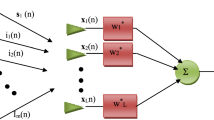Abstract
Recently, smart antenna systems (SAS) have emerged as frontiers for the wireless communication industries. The least mean square (LMS) algorithm and its different forms are the most widely used techniques for adaptive beamforming. Nonetheless, these methods deteriorate for adaptive beamforming due to fixed step size. The variable step size normalized LMS (VSSNLMS) is one of the most efficient methods presented in the literature to overcome the limitation of the LMS and its variants. Nonetheless, this method exploits the uniform linear array (ULA) which does not provide uniform adaptive beamforming. In this work, we improve the performance of the VSSNLMS by using the modified ULA. Furthermore, to make it more suitable for practical application, we deploy the hamming window to the proposed method to significantly suppress the sidelobe level. The array signal model and the computer simulations are presented to prove the effectiveness of the new method.







Similar content being viewed by others
Availability of data and material
Not applicable.
Code availability
Not applicable.
References
Ogawa, K., Yamamoto, A., & Takada, J. I. (2005). Multipath performance of handset adaptive array antennas in the vicinity of a human operator. IEEE Transactions on Antennas and Propagation, 53(8), 2422–2436.
Fang, G., Wang, X. M., & Gao, B. Q. (2006) “Effects of position uncertainties on the null width and depth of an adaptive array with Subarrays”. Dalian, pp 885–889,CEEM’.
Vaskelainen, L. I. (2007). Constrained least-squares optimization in conformal array antenna synthesis. IEEE Transactions on Antennas and Propagation, 55(3), 859–858.
Kawitkar, R. (2008). Issues in deploying smart antennas in mobile radio networks. World Academy of Science, Engineering and Technology, 17(5), 792.
Bakhar, Md., & Dr. Vani. R.M., and Dr. P.V. Hunagund,. (2009). Eigen structure based direction of arrival estimation algorithms for smart antenna systems. IJCSNS International Journal of Computer Science and Network Security, 9(11), 96–102.
Choi, S., & Shim, D. (2000). A novel adaptive beamforming algorithm for a smart antenna system in a CDMA Mobile communication environment. IEEE Transactions on Vehicular technology, 49(5), 1793–1807.
. Laseetha, T. J., & Sukanesh, R. (2011). “Analysis on robust adaptive beamformers”. (IJCSIS) International Journal of Computer Science and Information Security, 9(3): 171.
. Rana Liaqat Ali (2012) “A robust least mean square algorithm for adaptive array signal processing”, Wireless Pers Commun, Springer Science.
Bakhar, Md., Vani, R. M., & Hunagund, P. V. (2012). Microstrip linear phased array for smart antenna applications. International Journal of Electronics Engineering International Journal of Electronics Engineering, 4(1), 39–42.
Cheng, S. C., & Lee, K. C. (2012). Reducing the array size for doa estimation by an antenna mode switch technique. Progress In Electromagnetics Research, 131, 117–134.
Reddy, N. G., & Devi, K. R. (2013). Smart antennas adaptive beamforming through statistical signal processing techniques. International Journal of Research in Computer and Communication Technology, 2(8), 400–405.
Mohanna, M., Rabeh, M. L., Zieur, E. M., & Hekala, S. (2013). Optimization of MUSIC algorithm for angle of arrival estimation in wireless communications. NRIAG Journal of Astronomy and Geophysics, 2(1), 116–124.
Agatonovic, M., Stankovic, Z., Milovanovic, I., Doncov, N., Sit, L., Zwick, T., & Milovanovic, B. (2013). Efficient neural network approach for 2D DOA estimation based on antenna array measurements. Progress In Electromagnetics Research, 137, 741–758.
Narayana, V. L. (2013). Performance improvement in smart antenna by hybrid algorithm. International Journal of Advance Research in Computer Science and Management Studies, 1(4), 356.
Xuejun, M., & Hanhuai, P. (2013). An improved DOA estimation algorithm based on wavelet operator. Journal of Communications, 8(12), 839–844.
Motiur Rahaman, D. M., Moswer Hossain, Md., & Masud Rana, Md. (2013). Least mean square (LMS) for smart antenna. Universal Journal of Communications and Network, 1(1), 16–21.
Lee, K. H. (2013). Improve method on DOA estimation accuracy of signal subspace sensitivity based on mutual coupling matrix. International Journal of Smart Home, 7(3), 167–176.
Abdul, K. (2013). Evizal, “application of negative selection algorithm in smart antenna system for LTE communication.” Progress in Electromagnetic Research B, 56, 365–385.
Salunke, D. B., & Kawitkar, R. S. (2013). Analysis of LMS, NLMS and MUSIC algorithms for adaptive array antenna system. International Journal of Engineering and Advanced Technology (IJEAT), 2(3), 130–133.
Lee, W., Lee, S. R., Kong, H. B., Lee, S., & Lee, I. (2014). Downlink vertical beamforming designs for active antenna systems. IEEE Transactions on Communications, 62(6), 1897–1907.
Mukil Alagirisamy and Mandeep Singh. (2020). Efficient coherent direction-of-arrival estimation and realization using digital signal processor. IEEE Transactions on Antennas and Propagation, 68(9), 6675–6682.
Dakulagi, V. (2021). A new approach to achieve a trade-off between direction-of-arrival estimation and computational complexity. IEEE Communications Letters, 25(4), 1183–1186.
He, J. (2021). Improved direction-of-arrival estimation and its implementation for modified symmetric sensor array. IEEE Sensors Journal, 21(4), 5213–5220.
Wang, S., Gao, C., Zhang, Q., Dakulagi, V., Zeng, H., Zheng, G., & Zong, B. (2020). Research and experiment of radar signal support vector clustering sorting based on feature extraction and feature selection. IEEE Access, 8, 93322–93334.
Veerendra, D., He, J., & Shu, T. (2022). A planar-like sensor array for efficient direction-of-arrival estimation. IEEE Sensors Letters, 6(9), 1–4.
Funding
Not Applicable.
Author information
Authors and Affiliations
Corresponding author
Ethics declarations
Conflict of interest
The authors declare that they have no conflict of interest.
Additional information
Publisher's Note
Springer Nature remains neutral with regard to jurisdictional claims in published maps and institutional affiliations.
Rights and permissions
Springer Nature or its licensor holds exclusive rights to this article under a publishing agreement with the author(s) or other rightsholder(s); author self-archiving of the accepted manuscript version of this article is solely governed by the terms of such publishing agreement and applicable law.
About this article
Cite this article
Dakulagi, V., Dakulagi, R., Yeap, K.H. et al. Improved VSS-NLMS Adaptive Beamformer Using Modified Antenna Array. Wireless Pers Commun 128, 2741–2752 (2023). https://doi.org/10.1007/s11277-022-10068-7
Accepted:
Published:
Issue Date:
DOI: https://doi.org/10.1007/s11277-022-10068-7




